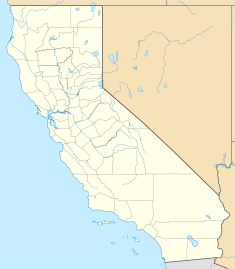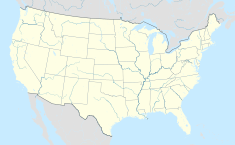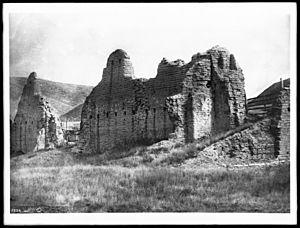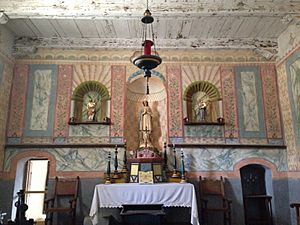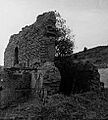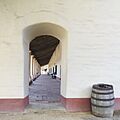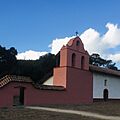La Purísima Mission facts for kids
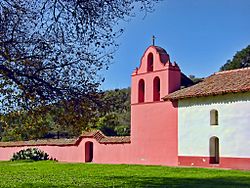
La Purísima Mission
|
|
| Location | 2295 Purisima Road, Lompoc, Santa Barbara County, California 93436 |
|---|---|
| Coordinates | 34°40′13.692″N 120°25′14.2206″W / 34.67047000°N 120.420616833°W |
| Name as founded | La Misión de La Purísima Concepción de la Santísima Virgen María |
| English translation | The Mission of the Immaculate Conception of the Most Blessed Virgin Mary |
| Patron | The Immaculate Conception of the Most Blessed Virgin Mary |
| Nickname(s) | "The Linear Mission" |
| Founding date | December 8, 1787 |
| Founding priest(s) | Father Fermín Lasuén |
| Founding Order | Eleventh |
| Headquarters of the Alta California Mission System | 1815–1819 |
| Military district | Second |
| Native tribe(s) Spanish name(s) |
Chumash Purisimeño |
| Native place name(s) | Laxshakupi, 'Amuwu |
| Baptisms | 3,255 |
| Marriages | 1,030 |
| Burials | 2,609 |
| Secularized | 1834 |
| Returned to the Church | 1874 |
| Governing body | California Department of Parks and Recreation |
| Current use | Museum |
| Designated | 1970 |
| Reference no. | #NPS-70000147 |
| Designated | 1970 |
| Reference no. | #340 |
| Website | |
| https://www.parks.ca.gov/?page_id=598 | |
Mission La Purísima Concepción, often called La Purísima Mission, is a historic Spanish mission located in Lompoc, California. Its full original name means "The Mission of the Immaculate Conception of the Most Blessed Virgin Mary."
This mission was started on December 8, 1787, by the Franciscan order. It is special because it is one of only two California missions not run by the Catholic Church today. It is also the only complete Spanish Catholic mission complex in California. In 1970, it was named a National Historic Landmark.
Contents
History of La Purísima Mission
The First Mission Site
The first La Purísima Mission was built in a place the Chumash people called Algsacpi. This spot was about one mile south of modern-day Lompoc. The Chumash people living there spoke the Purisimeño language.
Father Fermín Lasuén founded the mission on December 8, 1787. It was the 11th mission in California. The mission grew to be a large square building made of adobe bricks. It had rooms for priests, soldiers, and the Chumash people who lived there.
By 1803, about 1,436 Chumash people lived at the mission. They also had many animals, including cattle, sheep, and horses. The mission produced large harvests of wheat, corn, and beans.
However, a big earthquake on December 21, 1812, badly damaged the mission buildings. The original mission site is now a California Historical Landmark. You can find its ruins in Lompoc.
Building the Second Mission
After the earthquake, Father Mariano Payeras got permission to move the mission. They rebuilt it about four miles northeast of the old site. This new location was known to the Chumash as Amúu.
The new La Purísima Mission officially opened on April 23, 1813. Workers used materials saved from the damaged buildings to construct the new ones. It took about ten years to finish all the new buildings.
The Chumash Revolt of 1824
After Mexico became independent from Spain in 1823, the soldiers at the mission stopped getting paid. These soldiers often treated the local Chumash people poorly.
In 1824, a soldier reportedly beat a Chumash person at a nearby mission. This event sparked the Chumash revolt of 1824. The revolt quickly spread to La Purísima Mission. The Chumash people took control of the mission for about a month.
Eventually, more soldiers arrived from Monterey. The Chumash lost control of the mission. Many Chumash people left the mission after this event, though some later returned.
Mission Decline and Restoration
From 1834 to 1843, the Mexican government took control of the California missions from the Catholic Church. This process was called "secularization." The buildings at La Purísima Mission were abandoned and fell into ruin. The land became private property.
In the 20th century, people wanted to save the mission. In 1933, the Union Oil Company gave land to the State of California. By 1934, only nine buildings were still standing.
The Civilian Conservation Corps (CCC) helped restore the mission. They rebuilt the nine main buildings and many smaller structures. They also fixed the original water system. The restored mission was dedicated on December 7, 1941.
Today, La Purísima Mission is the only complete mission complex in California. Ten of its original buildings are fully restored and furnished. These include the church, shops, living quarters, and a blacksmith shop. The mission also has gardens and livestock that show what life was like in the 1820s.
Visitors can enjoy special "living history" events throughout the year. There is also a visitor center with information and artifacts. A self-guided tour lets people experience a glimpse into California's past.
La Purísima Mission State Historic Park
La Purísima Mission is now part of the La Purísima Mission State Historic Park. This park is managed by the California Department of Parks and Recreation. It covers 1,934 acres and is located outside Lompoc, California. The park was created in 1935.
The park has a visitor center and offers guided tours. It helps visitors learn about the mission's history.
Historic Designations
La Purísima Mission has several important historical designations:
- National Register of Historic Places – for both the original mission site and the State Historic Park.
- California Historical Landmark #928 – for the original mission site.
- Juan Bautista de Anza National Historic Trail – it is a designated Historic Site along this trail.
Gallery
See also
 In Spanish: Misión La Purísima Concepción para niños
In Spanish: Misión La Purísima Concepción para niños


